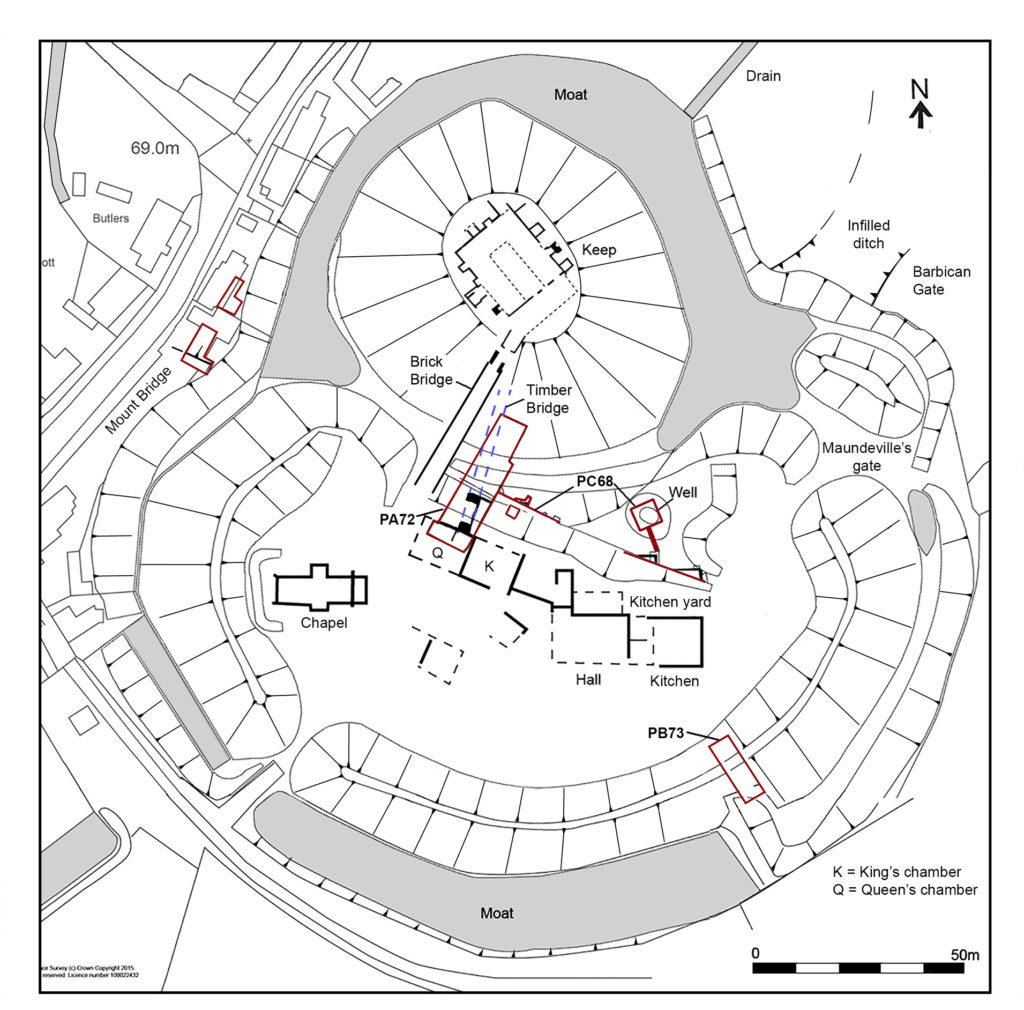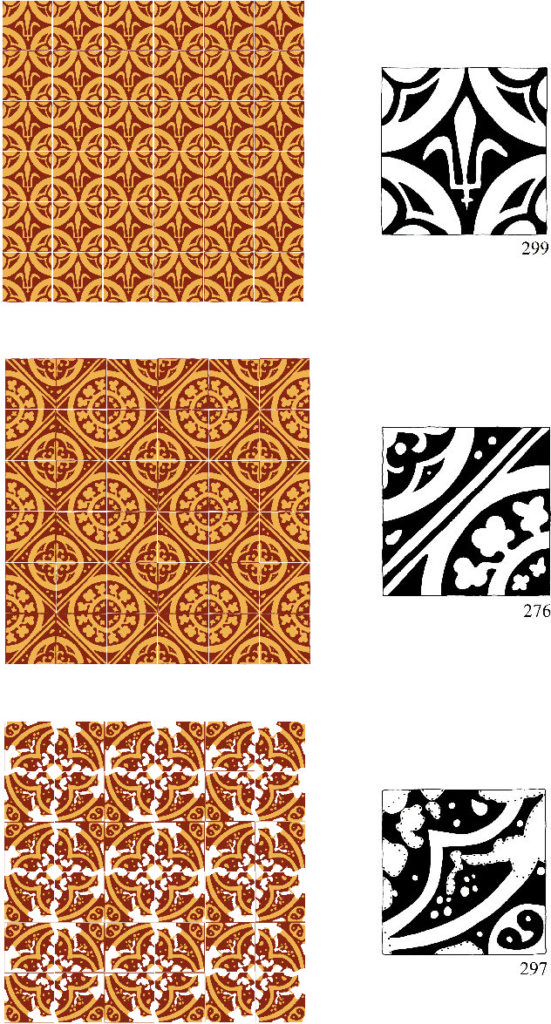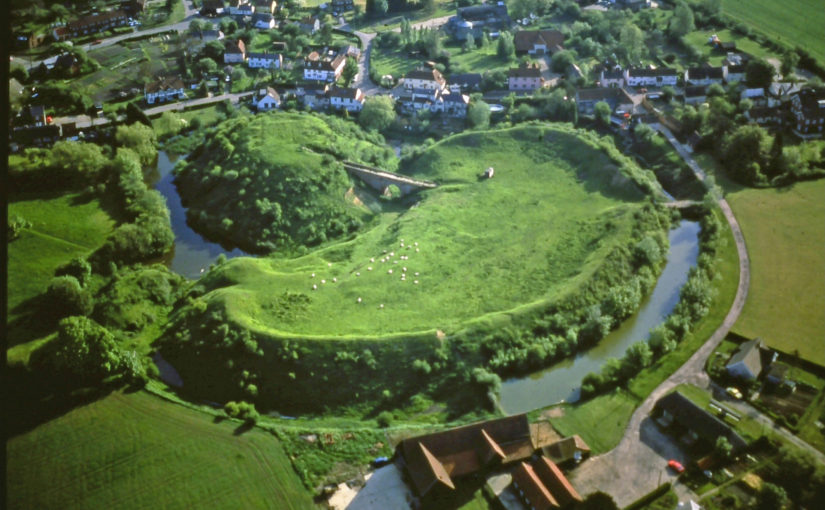Progress has continued to be made in the understanding of Pleshey Castle, as project lead Patrick Allen explains.
Subscribe to our quarterly newsletter
Since the publication of the article on Pleshey Castle in Current Archaeology (Issue 344, Nov. 2018, CST blog 15/09/20), we have been able to reconstruct in detail the gatehouse of the timber bridge over the motte moat, whose upper chamber is identified from building accounts for 1460-1 as the Queen’s privy chamber (‘Q’ on Fig.1). It would have been occupied by Queen Margaret of Anjou, wife of Henry VI, who held Pleshey between 1445 and 1461. Pottery dating, documentary evidence and the style of the floor tiles, however, suggest that the gatehouse was built in the 1380s by Thomas of Woodstock, duke of Gloucester, and the upper chamber would originally have been occupied by his wife, the duchess Eleanor. In the late medieval period, it was usual for accommodation to be provided above gateways. This gatehouse at Pleshey closed off the keep and the lord’s private quarters from the rest of the castle, but although it would have provided a degree of security it should not be confused with the heavily fortified gateways of castles with a more obviously military role.

FIGURE 1: Plan of the castle, with the queen’s chamber over the bridge gatehouse (Q) and the king’s chamber (K) immediately to its east, with the line of the timber bridge shown in blue. (Drawn by Iain Bell).
The physical character of the gatehouse can be reconstructed from specialist building material reports by David Andrews, Paul Drury and Nick Wickenden. The gatehouse was built of flint, with greensand dressings for the foundation plinth, corner stones, and door and window mouldings, with a peg-tile roof and lead gutters. Together with the chapel and the keep (which was timber but had a stone façade) it was one of the few stone buildings in the castle, as even the great hall in the bailey was of timber on stone sleeper walls. The ground floor room next to the gateway had a simple gravel floor and was probably a guardroom, but the upper chamber was luxurious. Its floor was of decorated glazed tiles made at Penn in Buckinghamshire, with three different roundel patterns (Fig. 2). Fragments of glass and lead cames show that the chamber had leaded glazed windows, while part of a chimney pot found in a spread of demolished roof tile implies that it was heated by a fireplace. The walls were plastered and decorated with simple painted designs, rather like modern wallpaper.

The chamber would have been dominated by a large four-poster bed with richly embroidered silk or fine wool hangings for curtains around it, as well as the tester for its canopy and the valence at its base. Several sets of these hangings are described in an inventory of goods seized from the castle following Thomas of Gloucester’s arrest and murder in 1397 (Dillon and Hope 1897). The chamber may have had tapestry wall hangings, also described in the inventory. The carpets that are mentioned would have been more like rugs and most of the decorated floor would have remained uncovered.
There was a general improvement in the private living quarters in the castle in the late 14th century, especially with the addition of fireplaces and privies. In the 1450s, when Pleshey was held by Queen Margaret of Anjou, the building accounts suggest that the keep had become guest accommodation, with the Queen’s chamber in the gatehouse and the King’s chamber next to it, approached by a ‘revealing’ or audience chamber (‘Q’ and ‘K’ on Fig. 1; Ryan 2010, 252). Queen Margaret would have been an absentee landlord as she spent most of her time at court, but these chambers would have been prepared for occasional visits. One such visit probably occurred when she ordered major building works at Pleshey early in 1458. After the defeat of the Lancastrians in 1461 Pleshey passed to the Yorkist Edward IV and, from 1465, Queen Elizabeth Woodville. Several entries in the building accounts for the 1460s record cleaning and refurbishment work before royal visits, and the gatehouse accommodation would still have been of a high standard, fit for a queen, eighty or so years after it was built.
Subscribe to our quarterly newsletter
References
Dillon, Viscount and Hope W.H.St.J. 1897, ‘Inventory of the goods and chattels belonging to Thomas, Duke of Gloucester and seized in the castle at Pleshey, Co. Essex, 21 Richard II (1397); with their value as show in the escheator’s accounts’, Archaeol. J., 54, 275-308 (transcript from PRO E 136/77/4): Available:
<https://www.archaeologicaldateservice.ac.uk/…/view/archjournal/contents.cfm?vol=54>
Ryan, P. 2010, ‘The fifteenth-century building accounts of the Duchy of Lancaster in Essex’, Essex Archaeol. Hist., 4th ser., 1, 248-60
Featured image courtesy of Chelmsford Museums Service.
